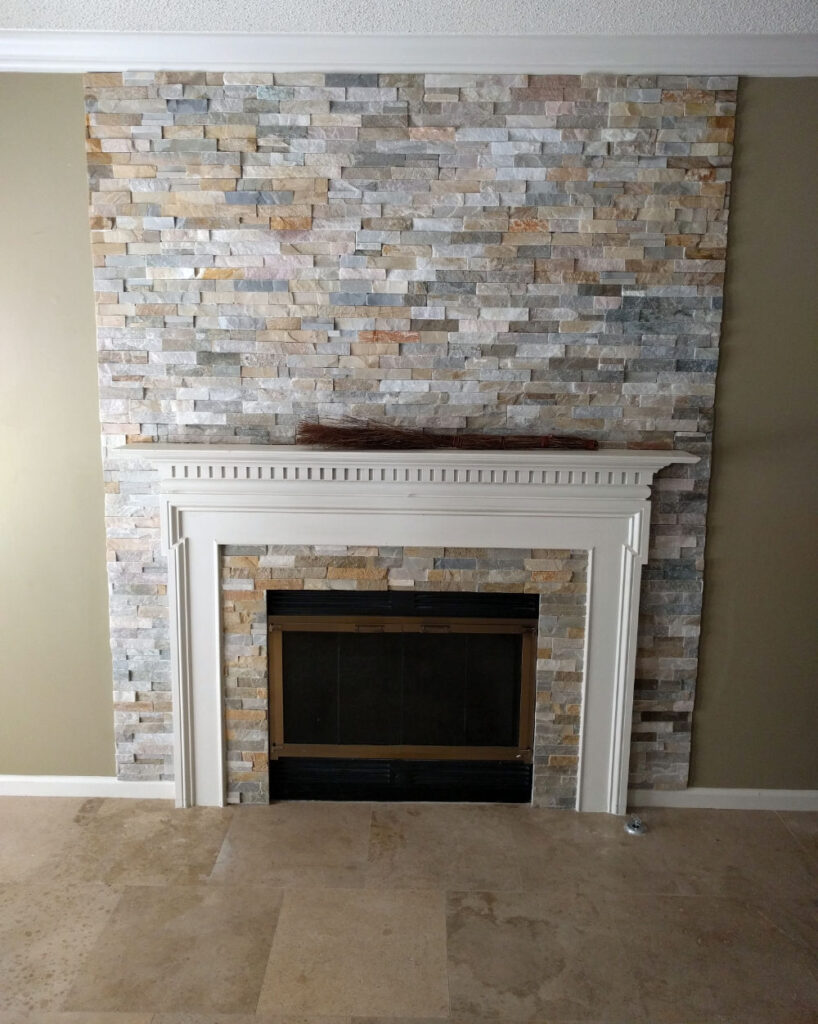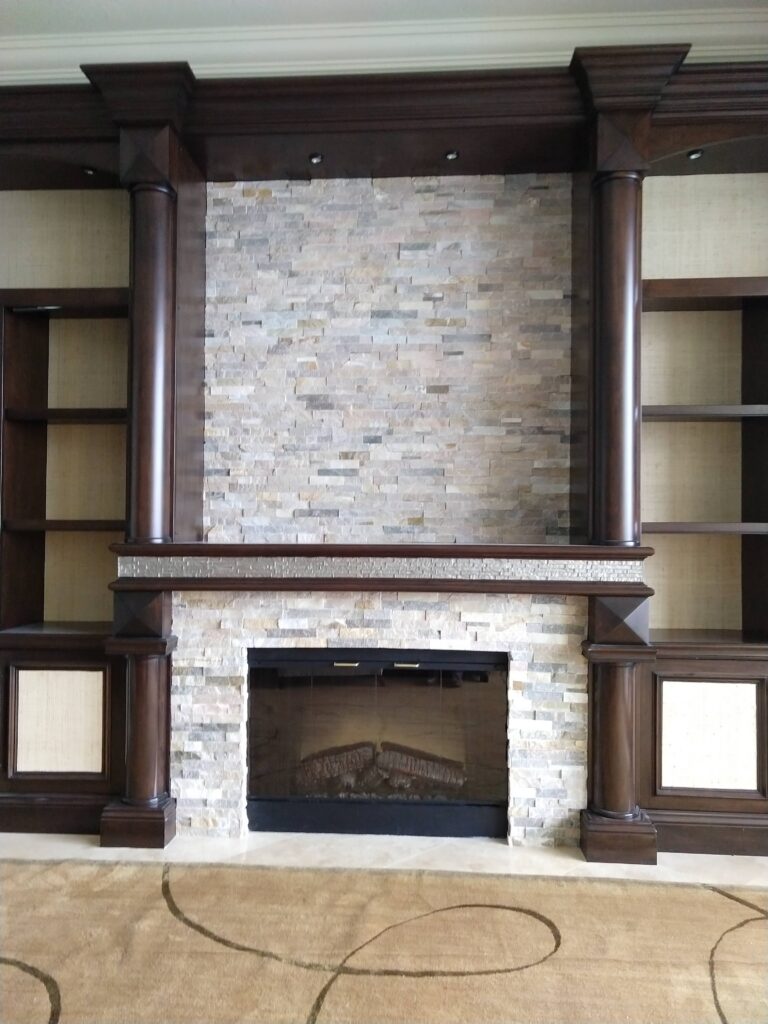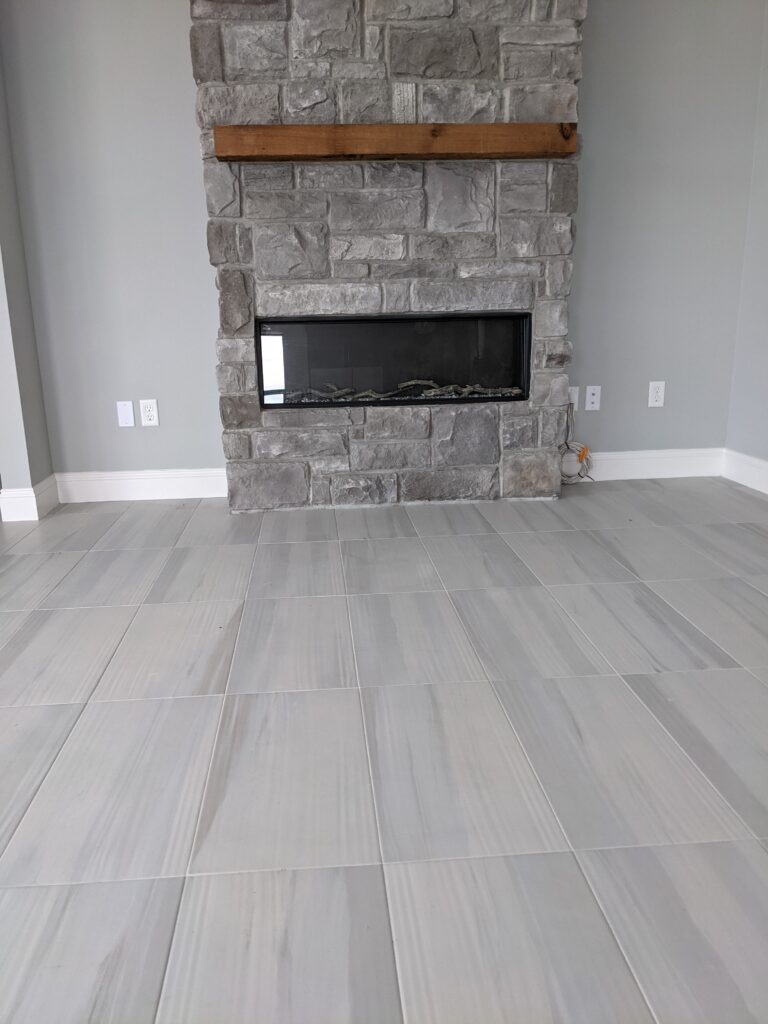Stone Fireplaces | Manufactured Stone Veneer for Fireplaces
The allure of a roaring fire framed by the rustic charm of stone or the sleek elegance of stone veneer is unmatched in home design. These elements not only serve as focal points in a room but also embody a blend of nature’s raw beauty with human craftsmanship.
This post delves into the nuances that make stone fireplaces and their veneer counterparts not just architectural features, but transformative elements of living spaces.
What a Difference a Joint Technique Can Make
Joint techniques in stone fireplace construction significantly influence the final aesthetic. Traditional grouted joints offer a classic look, while dry-stacked joints bring a contemporary edge. The choice between these can align a fireplace with the home’s overarching style or stand as a statement piece of contrast and character.
The Impact of Grout
Grout’s role extends beyond mere functionality to profoundly impact the visual appeal of stone fireplaces. The color and texture of grout can either highlight individual stones, creating a mosaic of natural beauty or blend seamlessly, giving the impression of a single, monolithic structure. This choice can subtly shift the ambiance of a room from rustic warmth to modern sophistication.
The Timeless Elegance of Stacked Stone
Stacked stone fireplaces epitomize timeless elegance. With each stone meticulously selected and placed, this style showcases the natural variations in color and texture, adding depth and dynamic interest to interiors.
Its versatility makes it suitable for enhancing both traditional homes and modern spaces with a touch of nature’s unpredictability.

Stone’s Versatile Palette
Variety in Colors, Textures, and Sizes
The beauty of stone lies in its diversity. From the deep, moody tones of slate to the warm, creamy hues of limestone, and the rich, variegated patterns of granite, the palette is as broad as nature itself.
This wide range of possibilities allows designers and homeowners to tailor fireplaces to personal tastes and existing décor, ensuring each fireplace is as unique as the individuals who gather around it.
Customizing Your Fireplace Stone
Choosing the right stone involves considering the room’s color scheme, lighting, and overall style. A well-chosen stone can elevate a fireplace from a mere heat source to a masterpiece of interior design, harmonizing with or accentuating the home’s architectural features.
Choosing Fireplace stone and stone veneer
When considering an upgrade or installation of a fireplace with stone or stone veneer, there are several important factors to keep in mind:
Aesthetic Appeal:
Stone brings natural beauty, warmth, and sophistication to any fireplace design. It comes in a variety of colors, textures, and styles, from rustic to contemporary, allowing for significant customization. Stone veneer offers similar aesthetic flexibility but can be more uniform in appearance, providing a different type of visual appeal.
Material Choice:
The choice between natural stone and stone veneer depends on several factors, including budget, desired look, and installation considerations. Natural stone is durable and unique but can be more expensive and heavier, requiring a stronger support structure. Stone veneer is lighter, easier to install, and often more cost-effective while still providing the look of natural stone.
Installation Process:
Installing natural stone requires skilled craftsmanship, especially to handle the weight and variability of the material. Stone veneer, on the other hand, is lighter and can be easier to install, making it a popular choice for DIY projects. However, both types of stone installations demand careful planning and preparation to ensure a secure and aesthetically pleasing result.
Durability and Maintenance:
Both natural stone and stone veneer are durable options for fireplaces, but they have different maintenance needs. Natural stone may require sealing to protect against stains and water absorption, depending on the type. Stone veneer, particularly manufactured veneer, may require less maintenance but should be inspected regularly for any signs of wear or damage.
Cost:
The cost of stone fireplaces can vary widely based on the type of stone, complexity of the design, and installation requirements. Natural stone tends to be more expensive both in material cost and installation labor. Stone veneer offers a more budget-friendly alternative with a similar aesthetic impact.
Heat Tolerance:
Both natural stone and stone veneer generally offer good heat resistance, making them suitable for use around fireplaces. However, it’s essential to choose materials that are specifically rated for high-temperature applications, especially for areas in close proximity to the firebox.
Environmental Impact:
Consider the environmental implications of your choice. Natural stone has a lower manufacturing impact but involves quarrying, which has its own environmental considerations. Manufactured stone veneer has a higher manufacturing footprint but uses fewer natural resources.
Resale Value:
Upgrading a fireplace with stone or stone veneer can increase a home’s aesthetic appeal and potentially its resale value. A well-designed stone fireplace can be a significant selling point, offering timeless elegance that appeals to many buyers. In summary, both natural stone and stone veneer offer unique benefits for fireplace designs, from aesthetic versatility to durability. The choice between them should be informed by considerations of cost, installation, maintenance, and the overall design vision for the space.

Cost Considerations
Is Manufactured Stone Cheaper Than Real Stone?
In general, manufactured stone veneer is less expensive than natural stone options. While initial costs may be lower, it’s crucial to consider longevity and the potential impact on property value.
Real stone, with its unmatched durability and prestige, may represent a higher upfront investment but pays dividends in both longevity and aesthetic integrity.
Longevity and Value
Manufactured stone veneer has made significant strides in durability, often lasting as long as its natural counterparts when properly maintained.
However, the timeless appeal and proven longevity of natural stone can enhance the resale value of a home, making it a worthwhile investment for many homeowners.
Construction Techniques
Dry-laid or Recessed Mortar Joints
The construction technique fundamentally alters the fireplace’s appearance and structural integrity.
Dry-laid joints, with their tight, seamless look, lend a modern flair, while recessed mortar joints highlight each stone’s shape and texture, adding depth and historical resonance to the design.
Installation Insights
Whether opting for natural stone or stone veneer, professional installation ensures the fireplace not only looks spectacular but functions safely.
The choice between DIY and professional installation often comes down to the complexity of the project and the homeowner’s skill level.
Durability and Maintenance
How Long Does Manufactured Stone Veneer Last?
With advances in manufacturing technology, stone veneer now rivals natural stone in lifespan, often enduring for decades with minimal care.
Regular inspections and gentle cleaning can extend this longevity, keeping the fireplace looking pristine.
Caring for Natural Stone Fireplaces
Natural stone requires regular sealing to resist stains and water damage. Gentle, pH-neutral cleaners preserve the stone’s natural beauty, ensuring it remains the heart of the home for generations.
Designing with Natural Stone Veneer
The Art of the Focal Point
A stone veneer fireplace can command attention, with natural stone thin veneer offering an authentic look that captivates and charms. It can set the tone for the entire room, reflecting the homeowner’s style and the home’s character.
Integrating Stones with Interior Themes
Whether aiming for a cozy, rustic vibe or a sleek, contemporary atmosphere, stone veneer fireplaces can be tailored to fit.
With a myriad of options in color, texture, and form, these fireplaces can complement any design scheme, from the boldly avant-garde to the comfortably traditional.
Integrating an existing brick fireplace
Transforming an existing brick fireplace into a stunning focal point can redefine the ambiance of any room.
Whether it’s embracing the charm of natural stone or the versatility of stone veneer, this upgrade seamlessly blends traditional and contemporary styles.
Conclusion
Stone fireplaces and stone veneer fireplaces offer more than warmth; they provide a connection to the natural world, grounding our spaces in the beauty of the earth.
Whether it’s the genuine charm of natural stone or the adaptable allure of manufactured veneer, these fireplaces have the power to turn any space into a haven.

FAQ
What is river rock?
River rock refers to stones that have been naturally smoothed and rounded over time by the continuous flow of water in rivers and streams. These rocks vary in size, from small pebbles to larger boulders, and they can come in a wide range of colors, including but not limited to, shades of white, grey, brown, and black.
The smooth texture and diverse color palette of river rocks are a result of geological processes and the mineral composition of the original rock. Their aesthetic appeal and durability make them a favored choice for adding natural, earthy elements to both outdoor and indoor spaces.
What is the difference between stone veneer and faux stone?
The terms “stone veneer” and “faux stone” are often used interchangeably in the context of home decoration and construction, but they can refer to distinct products with different characteristics and applications.
Stone Veneer
Stone veneer typically refers to thin slices of natural stone that are used to simulate the look of solid stone construction. These veneers are made from real stone that is quarried and then cut into thin pieces. The primary advantage of stone veneer is its authentic stone appearance, as it is, in fact, made from real stone. This gives it a natural variability in color and texture that is hard to replicate. Stone veneers are used in both interior and exterior applications, including fireplaces, walls, facades, and landscaping features. They require some level of maintenance to preserve their natural beauty and may need to be sealed to protect against moisture and weathering.
Faux Stone
Faux stone, also known as manufactured stone veneer or artificial stone, is a man-made product designed to mimic the look of natural stone. It is typically made from concrete, polymers, and color pigments molded and colored to resemble various types of stone. The benefits of faux stone include lower cost, lighter weight, and easier installation compared to natural stone veneer. Faux stone is versatile and can be used in a wide range of applications, both indoors and out. However, it may not achieve the same depth of character and variation found in natural stone, although advances in manufacturing techniques have significantly improved its appearance. Faux stone requires minimal maintenance, usually just cleaning, and is resistant to weathering and fading.
Key Differences
- Material Composition: Stone veneer is made from real stone, while faux stone is a manufactured product.
- Appearance: Stone veneer offers the authentic look and variability of natural stone, whereas faux stone attempts to replicate this appearance with varying degrees of success.
- Weight and Installation: Faux stone is generally lighter and easier to install than stone veneer, making it suitable for a wider range of projects and often a favorite for DIY enthusiasts.
- Cost: Faux stone is typically less expensive than natural stone veneer, both in terms of material cost and installation expenses.
- Maintenance: Stone veneer may require more maintenance, including sealing, to protect against moisture and wear. Faux stone is designed to be low maintenance.
In summary, the choice between stone veneer and faux stone depends on the project requirements, budget, desired aesthetic, and maintenance preferences. Both options offer a way to achieve the look of stone in construction and design projects, each with its own set of advantages.
